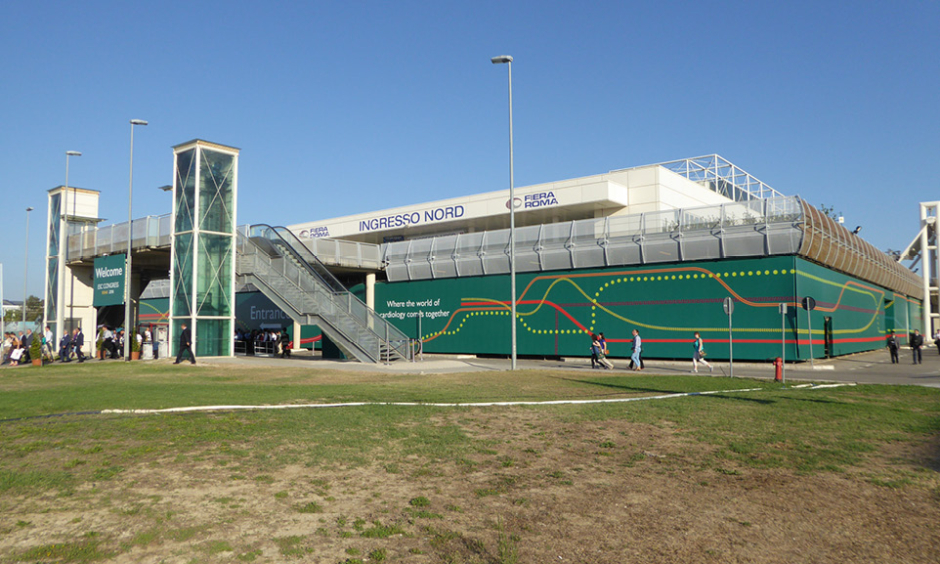Rome is home to a plethora of art and culture and this year it was also home to the annual ESC Congress. Taking place over 5 days, this event included more than 500 sessions for its 33,000 attendees, who represented 140 different countries. The developments presented this year were of the highest quality, with nearly 11,000 initial submissions whittled down to just over 4,500 of the best abstracts. There were also 26 clinical trial updates and a number of ‘gladiator style’ debates on some of the most controversial issues.
Speaking at the Opening Ceremony in Rome, Chair of the Congress Programme Committee Prof Geneviève Derumeaux commended the attendees for their “enthusiasm and active contribution,” and elaborated on her “personal wish to you that you will make it your own ESC congress. First you can take away from these 5 days of congress all the experience, knowledge, and learning you can get, that will make a difference for you, your heart team, and your patients.”
His Holiness Pope Francis also gave an impassioned speech to the ESC delegates, in which he thanked the delegates for their work and dedication to their patients, as well as emphasising the “importance of scientific research for human life and health.”
Two ESC gold medals were presented at the event; this is the highest honour that the society bestows upon individuals who have made a substantial contribution to cardiovascular medicine. Alain Cribier, France, who developed and performed the world’s first transcatheter aortic valve implantation was the first recipient. The second was given to Bernard Gersh, USA, who has published pivotal research in atrial fibrillation, percutaneous coronary intervention, and many other topics. On receiving the medal, Gersh commented: “I am really thrilled by this totally unexpected honour. It is a highlight of my career. Awarding the ESC gold medal to non-Europeans emphasises the worldwide fraternity of academic cardiology.”
The society also gave two Outstanding Achievement Awards; this award is given to basic researchers who have made significant developments early in their careers. The first of these was given to Charalambos Antoniades, UK, whose research focusses on the interplay between adipose tissue and vascular/myocardial redox signalling. The second was awarded to Sabine Steffens, Germany, who conducts research in the field of atherosclerosis and vascular biology, with a particular focus on the endocannabinoid system.
This year also featured the development of four new guidelines in atrial fibrillation, heart failure, cardiovascular prevention and dyslipidaemia, and cardio-oncology. These reflect the ever-growing multidisciplinary team in cardiovascular medicine. Within these guidelines, you will find new information from the latest trials and systematic reviews to provide you with the most up-to-date clinical strategies to adopt into your own practice.
Moving forward, ESC President Prof Fausto Pinto announced a 5-year plan from 2016–2020, which involves plugging the gap between cardiovascular knowledge and routine clinical care, incorporating advocacy, research, education, congress, and membership. Key points include membership packages to engage cardiologists with activities and research, developing a think-tank to direct policy, and to create a virtual congress concept for improved information accessibility.
Further updates can be found in our congress review where we present some of the highlights of ESC 2016, including a look at the benefits of invasive imaging in percutaneous coronary intervention and a number of negative results that challenge conventional thinking. We also present a number of abstract reviews, where you will find summaries of some impactful presentations from the congress directly from the researchers themselves.
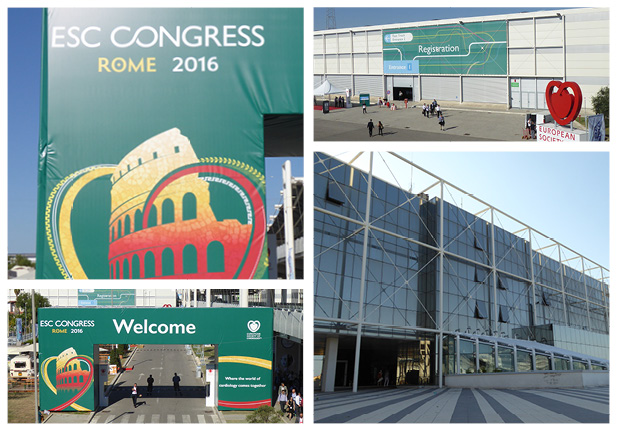
Invasive Imaging Improves Outcomes in Percutaneous Coronary Intervention
IMPROVED outcomes in percutaneous coronary intervention (PCI) have been achieved using an invasive imaging technique called optical coherence tomography (OCT) to visualise coronary arteries when treating acute coronary syndrome (ACS), according to a ESC press release dated 29th August 2016.
For the DOCTORS trial, 240 non-ST-segment elevation ACS patients were randomised 1:1 to standard fluoroscopy-guided PCI alone (the angiography group) or with the addition of OCT, in order to explore the procedural and functional implications of the latter.
Compared to standard angiography-guided PCI, OCT was found to be significantly more likely to reveal clinically relevant factors; for example, stent underexpansion in 42.0% versus 10.8% of patients, edge dissection in 37.5% versus 4.0%, and incomplete lesion coverage in 20.0% versus 17.0%, respectively.
OCT allowed clinicians to see more thrombi (69.0% versus 47.0%, p=0.0004) and calcifications (45.8% versus 9.0%, p<0.0001) prior to stent implantation. Thus, more frequent antiplatelet use occurred in the OCT group compared to angiography (53.3% versus 35.8%). Stent malapposition was identified in 32% of OCT patients, facilitating more frequent use of post-stent overinflation in the OCT group (43.0% versus 12.5%, p<0.0001) and a lower residual stenosis (7.0% versus 8.7%, p=0.01).
Along with procedural improvements, the trial highlighted positive functional outcomes. Fractional flow reserve (FFR) results were significantly better in the OCT group than the angiography group (0.94 versus 0.92, p=0.005). Measures of post-procedural FFR >0.90 were significantly higher in patients in the OCT group (82.5% versus 64.2%, p=0.0001). “The improvement in functional outcomes could translate into a clinical benefit in the longer term,” concluded lead investigator of the trial Prof Nicolas Meneveau, Department of Cardiology, University Hospital Jean Minjoz, Besançon, France.
Although procedure time was increased by using OCT, as well as patient exposure to fluoroscopy and contrast medium, there was no increase in complications. Further prospective studies with clinical endpoints are required before considering the incorporation of OCT guidance as standard practice.
Non-Invasive Computed Tomography Guides Selective Invasive Coronary Angiography
COMPELLING evidence has displayed the significant benefits of using non-invasive coronary computed tomographic angiography (CCTA) to guide the selective use of invasive coronary angiography (ICA) in stable symptomatic patients with suspected coronary artery disease (CAD).
Investigators from the CONSERVE trial observed that this strategy was safe and less expensive than direct ICA, according to a ESC press release dated 29th August 2016.
“The message from the trial is that if we use CCTA as a gatekeeper to the catheterisation lab in stable symptomatic patients with suspected CAD, we will reduce costs with sufficient safety,” commented Prof Hyuk-Jae Chang, Division of Cardiology, Yonsei University College of Medicine, Seoul, Republic of Korea.
In the randomised, controlled, multicentre trial, the patients (N=1,530) were randomised to direct versus selective invasive ICA, the latter of which was decided by physician referrals based on initial results of the CCTA. All the patients had indications for invasive angiography, based on current guidelines.
The computed tomography (CT)-guided strategy was associated with no variation in major adverse cardiovascular events (MACE), resulting in an 86% reduction in invasive procedures, which reduced costs whilst not affecting patient safety. The primary endpoint of 12-month MACE rates were 5% in both groups. The secondary endpoint of mean cardiovascular cost per patient was lower in the selective versus direct ICA arm ($2,883 versus 6,031).
Prof Chang also argued that the significant reduction in invasive procedures is clinically important: “CT-guided strategy may uncouple the diagnosis-treatment cascade of ICA which promote[s] excess revascularisation and subsequently exposes patients to non-negligible risk related to invasive procedures.”
These findings could therefore ensure that significant savings are made for healthcare systems in the future. Using Medicare costs, there was a $3,000 saving per person in the trial over 12 months. Based on these calculations, a potential 10 billion dollars could be saved each year considering the 4.6 million catheterisations that take place.
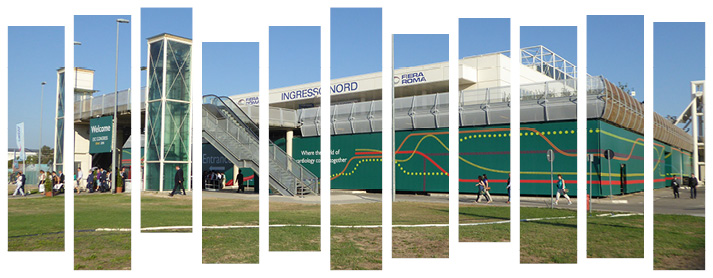
DANISH Study Reveals Gap in Current Heart Failure Guidelines
ILLUMINATING new evidence has suggested that an implantable cardioverter-defibrillator (ICD) should not be used in all instances of systolic heart failure, revealing that current European and American guidelines may need updating. This is according to a ESC press release dated 28th August 2016.
Currently: “Prophylactic ICD implantation is a Class I recommendation in patients with heart failure and reduced left ventricular systolic function in both European and American Guidelines,” explained Prof Lars Køber, Rigshospitalet, Copenhagen University Hospital, Copenhagen, Denmark. However, this evidence is considerably weaker for non-ischaemic aetiology. The DANISH study indicated that in instances where a patient is suffering from non-ischaemic systolic heart failure, ICDs will not improve overall survival in comparison to the usual clinical care.
The study involved a total of 1,116 patients, 560 of whom were in the control group who received usual clinical care, consisting of guideline-recommended medication including beta blockers, renin-angiotensin inhibitors, and mineralocorticoid-receptor antagonists. The remaining 556 patients received an ICD. Across both groups, 58% of patients also needed cardiac-resynchronisation therapy.
The results of the study at a median follow-up time of 67.6 months showed no statistically significant difference when comparing the primary outcome of death from all causes, which occurred in 21.6% of ICD patients and 23.4% of the control group (hazard ratio [HR]: 0.87; 95% confidence interval [CI]: 0.68–1.12, p=0.28). Sudden death on the other hand occurred in 4.3% of the ICD patients and was almost double at 8.2% in the control group (HR: 0.50; 95% CI: 0.31–0.82, p=0.01). Device-related infection occurred in both groups.
Investigators of the study also pointed out the significance of age during the trial, determining that: “Patients younger than 68 years of age had a significant reduction in all-cause mortality if they received an ICD (HR: 0.64; 95% CI: 0.45–0.90, p=0.01), suggesting that younger patients may have a survival benefit with ICD implantation.”
Wireless Cardiac Devices Reduce Financial Burden of Heart Failure
DIGITAL devices are innovating clinical procedures across the medical landscape. Remote monitoring (RM) of defibrillator therapy in heart failure (HF) patients was recently applied in order to explore its clinical and economic value according to a ESC press release dated 28th August 2016.
RM has previously been demonstrated to reduce the delay from cardiac event to clinical decision in HF patients, suggesting the potential for a further phase of study evaluating the outcomes of these devices. HF is common and imposes a financial weight at the level of both the individual patient and the healthcare system. In this respect, although the multicentre trial was underpowered to draw conclusions regarding its primary endpoint, the RM results illuminated some particularly relevant findings related to the use of healthcare resources.
HF patients (N=917) were fitted with a biventricular defibrillator able to wirelessly transmit data. After 8 weeks patients were randomised, 455 patients were assigned standard in-office follow-up and 462 were scheduled for alternating remote and in-office checks. Despite an insignificant difference in primary endpoint at the median 24-month follow-up, the secondary outcomes proved insightful. HF imposes a financial weight on both the individual patient and the healthcare system, but through the alternation of follow-up procedure in the remote arm, the frequency of scheduled visits was reduced, resulting in 2-year savings of €2,899 per 100 patients (incidence rate ratio: 0.59, 95% confidence interval: 0.56–0.62, p<0.001).
“Healthcare resource utilisation for cardiovascular reasons was 38% lower in the remote versus the standard arm, and there was an estimated cost-saving that went along with that, both from the perspective of the healthcare system, but also in terms of personal patient travel costs,” elucidated Prof Giuseppe Boriani, Cardiology Department, University of Modena and Reggio Emilia, Modena, Italy. Indeed, the individual 2-year travel cost savings were noted at an average of €145 per patient. Finally, although it was pointed out that real-world comorbidities may influence the relative impact of RM on these outcomes, there were no safety issues reported in this study.
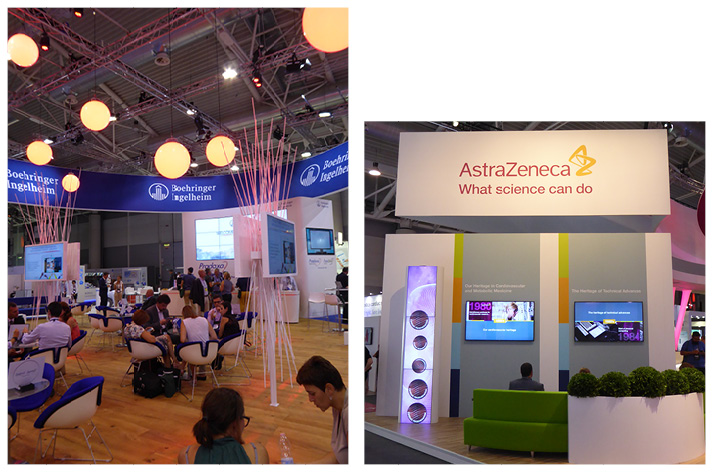
Potential for Future Research Directions Following the HIJ-PROPER Trial
RESULTS from the HIJ-PROPER trial give potential research directions in the treatment of acute coronary syndrome (ACS) and dyslipidaemia with low-density lipoprotein (LDL) cholesterol-lowering medications. The study, which showed that treatment with a second-line cholesterol-lowering medication in addition to a standard statin did not significantly improve survival and other cardiovascular outcomes compared to statin treatment alone for these conditions, was presented in a ESC press release dated 29th August 2016.
The study randomised 1,734 patients with ACS and dyslipidaemia to either a combination of a statin (pitavastatin) plus a second-line, cholesterol-lowering drug (ezetimibe) aiming for an LDL level of ≤70 mg/dL, or to pitavastatin alone aiming for an LDL level of 90–100 mg/dL. The primary endpoint for the trial was a composite of all-cause death, non-fatal myocardial infarction, non-fatal stroke, unstable angina, or revascularisation with percutaneous coronary intervention or coronary artery bypass grafting.
More intensive treatment was not associated with significantly better rates of any aspect of the primary endpoint (hazard ratio [HR]: 0.89, 95% confidence interval [CI]: 0.76–1.04, p=0.152) following 3-year follow-up. However, Dr Nobuhisa Hagiwara, Tokyo Women’s Medical University, Tokyo, Japan, explained: “Although the results from our study were negative, they also suggest a potentially interesting direction for future research.”
A subgroup of patients with higher baseline levels (>2.2 μg/mL) of sitosterol, a cholesterol absorption marker, did gain significant benefit from receiving the intensive treatment course. This group had a significantly lower occurrence of the primary endpoint outcomes (HR: 0.71, 95% CI: 0.56–0.91, p=0.010). Currently, <30% of these higher-risk patients reach their target LDL cholesterol level when treated with a statin alone. This may be important as statins do not inhibit cholesterol absorption.
“We now think that inhibiting cholesterol absorption may be instrumental in reducing cardiovascular events in ACS patients with high cholesterol absorption. This subanalysis from the HIJ-PROPER trial suggests that combined inhibition of both cholesterol synthesis and cholesterol absorption may help us reduce cardiovascular events in these patients,” added Dr Haigwara.
Lower Cholesterol and Blood Pressure Reduces Cardiovascular Disease Risk
DRAMATIC reductions in the risk of developing cardiovascular disease could be achieved through the combination of slightly lower low-density lipoprotein cholesterol (LDL-C) and systolic blood pressure (SBP) over a long period, as reported in a ESC press release dated 29th August 2016. Previous studies had shown that both LDL-C and SBP have causal and cumulative effects on the risk of cardiovascular disease, leading to the hypothesis that long-term exposure to lower LDL-C and SBP could be an effective prevention strategy.
Genetic scores were calculated for 102,773 individuals from 14 prospective cohort or case-control studies. These scores were based on inherited polymorphisms known to be linked with LDL-C or SBP and the number of alleles associated with raised LDL-C or SBP levels. Participants were separated into four groups: i) reference group; ii) LDL-C genetic score below the median; iii) SBP genetic score below the median; and iv) LDL-C and SBP genetic scores below the median. This enabled the researchers to analyse the cardiovascular risk associated with different genetic scores.
A composite of either coronary death, non-fatal myocardial infarction, non-fatal stroke, or coronary revascularisation was the primary outcome, with 14,368 primary events recorded overall. The results showed that there was a 54.2% lower risk of the primary outcome in the lower LDL-C group, a 44.7% lower risk in the lower SBP group, and an 86.1% lower risk in the combined LDL-C and SBP group, compared with the reference group.
Lead investigator Prof Brian Ference, Wayne State University School of Medicine, Detroit, Michigan, USA, commented: “The results of our study confirm that cardiovascular disease is largely preventable and suggest that this prevention can be substantially simplified by focussing on programmes that promote long-term exposure to the combination of both lower LDL and lower SBP.” Future studies should focus on identifying for whom this early intervention would be most beneficial.
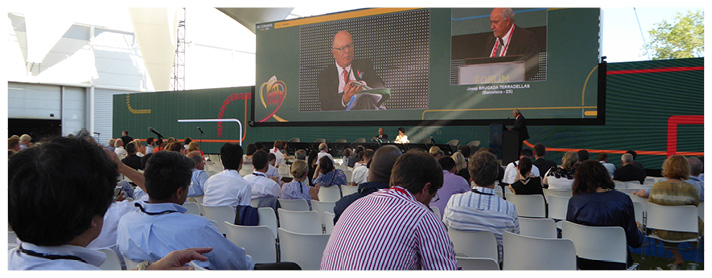
Short-Term Dual Antiplatelet Therapy: Is it Non-Inferior?
TREATMENT duration with dual antiplatelet therapy (DAPT), following the placement of a drug-eluting stent (DES), was under evaluation in a recent trial that set out to compare a shorter 6-month treatment course with a longer 18-month one.
For the study, 3,775 patients were enrolled with coronary artery disease or acute myocardial infarction who had undergone percutaneous coronary intervention and placement of a Nobori® bioabsorbable abluminal-coated stent. The cohort was randomised to receive DAPT consisting of aspirin (81–162 mg/day) combined with clopidogrel (75 mg/day) or ticlopidine (200 mg/day) for 6 or 18 months. Following an interim analysis, the study was terminated early, leaving 2,772 patients with a minimum follow-up of 18 months for scrutiny.
According to a ESC press release dated 28th August 2016, the primary outcome measured was the rate of net adverse clinical and cerebrovascular events (NACCE), including all-cause death and Q-wave or non-Q-wave myocardial infarction. The results showed that there was only a 0.46% difference in occurrence of NACCE between short-term and long-term DAPT treatment arms (1.92% versus 1.45%, respectively): the rate of bleeding events was similar (0.96% versus 0.73%, respectively) and the rate of stent thrombosis was identical. This led to the conclusion that the shorter period of DAPT was non-inferior to a longer duration of DAPT following DES placement.
However, trial investigator Prof Masato Nakamura, Toho University Ohashi Medical Centre, Tokyo, Japan, commented: “The results of the present study should be interpreted with caution before trying to draw firm conclusions.” This is due to study limitations, including: the lack of adherence due to the non-double blinding of the trial, the lack of events resulting in an inadequate statistical power and wide non-inferiority margin, and the patient cohort potentially being unrepresentative of high-risk patients.
Despite these drawbacks, Prof Nakamura was confident in the results: “Based on these findings, a combination of short DAPT and a newer DES with bioabsorbable abluminal coating should be able to minimise the incidence of thrombotic events and bleeding complications simultaneously.”
No Difference Between Prasugrel and Ticagrelor at 1 Month
FINDINGS from the PRAGUE-18 trial has shown similarities between the antiplatelet drugs prasugrel and ticagrelor in terms of safety and efficacy in patients with acute myocardial infarction and ST-segment elevation myocardial infarction (STEMI), according to a ESC press release dated 30th August 2016.
PRAGUE refers to a succession of academic randomised trials by the Cardiocenter of Charles University, Prague, Czech Republic, beginning in 2000.
The Hot Line study randomised 1,230 patients to treatment with either prasugrel (60 mg followed by 10 mg/day [reduced to 5 mg/day if >75 years or <60 kg]) or ticagrelor (180 mg followed by 90 mg twice a day) before primary percutaneous coronary intervention. Both treatments were to be taken for 1 year. The primary endpoint was defined as death, stroke, re-infarction, urgent target-vessel revascularisation, serious bleeding that required transfusion, and ongoing hospitalisation at 7 days. However, when an interim analysis indicated no difference in the rate of the endpoint between the two groups of patients (4.0% in the prasugrel group and 4.1% in the ticagrelor group, p=0.939), the study was terminated earlier than initially intended.
The secondary endpoint was defined as cardiovascular death, non-fatal myocardial infarction, or stroke within 30 days. Again, there was no difference in the rate of the secondary endpoint between the two groups (2.7% prasugrel group versus 2.5% ticagrelor group, p=0.864).
Prof Petr Widimsky, Cardiocenter of Charles University, Prague, Czech Republic, commented: “Our findings confirm previous indirect, non-randomised, comparisons of these two drugs, based on analyses of various registries.” He added: “Thus, both drugs are very effective and safe and significantly contribute to the excellent outcomes of patients with acute myocardial infarction in modern cardiology.”
For all patients, the final follow-up will be at 1 year, and the study will be completed in 2017.
“These study results offer more freedom to clinicians to select the antiplatelet agent added on top of aspirin for patients with STEMI who receive dual antiplatelet therapy,” added Prof Widimsky.

No Benefit to Platelet Monitoring in Elderly Patients
INTERNATIONAL guidelines regarding testing platelet function in elderly patients following a heart attack have been challenged by the results of a recent study showing that the tests do not improve outcomes. The trial, according to a ESC press release dated 28th August 2016, is the first to examine platelet function testing in patients aged ≥75 years with a high risk of ischaemic and bleeding complications.
For the ANTARCTIC study, 877 patients with acute coronary syndrome who had undergone coronary stenting were given the antiplatelet agent prasugrel (5 mg), of whom 435 were randomised to additional monitoring and dose adjustment where required. In this group, patients received the prasugrel dose for 14 days before undergoing a platelet function test on Day 14. Their medication was adjusted depending on the results of the test with further tests carried out on Day 28 if required. Alongside these patients, 442 were randomised to receive a standard therapy with no adjustment.
Composite of cardiovascular death, myocardial infarction, stroke, stent thrombosis, urgent revascularisation, and bleeding complication at 1-year follow-up were listed as the primary endpoints of the study, the rate of which was similar in both arms of the study. In the more closely monitored group, the rate was recorded at 27.6%, whereas in the control group 27.8% was recorded (hazard ratio: 1.003, 95% confidence interval: 0.78–1.29, p=0.98). The team similarly noted no significant difference between the two groups for the secondary endpoint, which comprised cardiovascular death, myocardial infarction, stent thrombosis, or urgent revascularisation. This was demonstrated in 9.9% of the monitored group and 9.3% of the control group.
“Platelet function monitoring led to a change of treatment in 44.8% of patients who were identified as being over or undertreated, yet this strategy did not improve ischaemic or safety outcomes,” explained Prof Gilles Montalescot, Pitié-Salpêtrière Hospital, Paris, France. “I expect there will be adjustments of guidelines and practice in light of this.”
Potential New Treatment Option for Refractory Angina
A POTENTIAL novel treatment for refractory angina has been exhibited in a study presented at ESC 2016. Lipoprotein apheresis was shown to significantly improve the primary endpoint of myocardial perfusion reserve, as measured by magnetic resonance imaging. The secondary endpoints included quality of life in patients with refractory angina with elevated levels of lipoprotein(a) (Lp[a]), in comparison to sham therapy.
“Angina, which is refractory to both medical therapy and revascularisation, is a debilitating condition that is increasing in frequency and there is a pressing need for novel treatments for these patients,” explained lead investigator Dr Tina Khan, Royal Brompton and Harefield NHS Trust, London, UK, in a ESC press release dated 29th August 2016. There is also currently no effective pharmacologic treatment approved to treat raised Lp(a), which can be present in patients with refractory angina; however, lipoprotein therapy can effectively lower Lp(a) levels.
In the prospective, randomised, sham-controlled, blinded, cross-over study, 20 patients with refractory angina and elevated Lp(a) levels >500 mg/L were randomised to either weekly lipoprotein apheresis or sham treatments for 3 months before being crossed over for a further 3 months with a washout period of 1 month in between.
The primary outcome of myocardial perfusion reserve, measured with cardiac magnetic resonance imaging, increased from 1.45 to 1.93 with lipoprotein apheresis, with no significant changes following sham therapy. In addition, improvements were seen in the secondary endpoints after apheresis in comparison to sham. These were in carotid wall volume, distensibility, exercise capacity, and quality of life scores. There were also significant improvements in symptoms, as measured by the Seattle Angina Questionnaire (SAQ), such as physical limitation score (median change of +27.8 versus -4.2), and quality of life score (mean change of +25.8 versus +4.6).
“These findings suggest that lipoprotein apheresis provides significant clinical benefit to patients with refractory angina in the context of raised Lp(a), representing a much needed novel treatment option for this therapeutically challenging patient cohort,” stated Dr Khan.
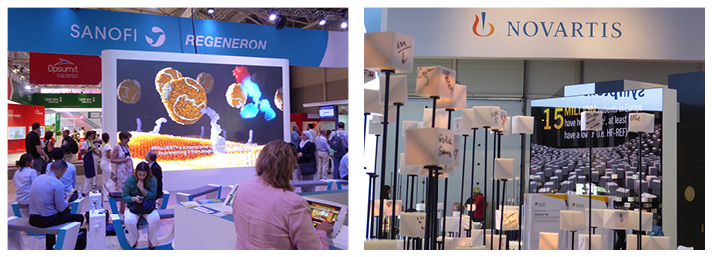
Non-Invasive Approaches Go Head-to-Head
THE PACIFIC trial, presented at this year’s ESC Congress, is the first in its field to compare non-invasive coronary artery imaging techniques in order to determine which is best for coronary artery disease patients, according to a ESC press release dated 29th August. Evidence regarding the best course of action has previously been scarce and no real consensus currently exists among clinicians in both the USA and Europe.
The trial compared the most frequently used techniques to measure myocardial perfusion or coronary artery stenosis. Positron emission tomography (PET), single photon emission computed tomography (SPECT), and coronary computed tomography angiography (CCTA) went head-to-head.
Initially, participants of the study (N=208) with suspected coronary artery disease underwent the gold-standard, invasive coronary artery angiography test. Participants then went on to receive PET, SPECT, and CCTA, as well as hybrid combinations of PET and CCTA, or SPECT and CCTA to enable a variety of assessments to be made.
The results of the study demonstrated that, at 85%, PET is significantly more accurate for diagnosing coronary ischaemia compared to SPECT (77%, p<0.01) and CCTA (74%, p<0.01). Regarding the sensitivity of these approaches, PET, SPECT, and CCTA were 87%, 57%, and 90%, respectively. Finally, the specificity between the approaches stood at 60% for PET, 84% for SPECT, and 94% for CCTA. Diagnosis was not enhanced by the hybrid techniques.
Dr Ibrahim Danad, Research Fellow, University Medical Center, Vrije University, Amsterdam, Netherlands, who presented the findings at this year’s congress, signals the importance of such research stating that: “The results will definitely spark further research. There is always a lot of discussion whether we need to choose SPECT or PET as the initial functional test for our patients. I think we need to invest more in clinical PET imaging, which will be [the] future. It is more convenient for patients in terms of time, accuracy, and radiation dose.”
YEARS Algorithm Reduces Need for Imaging of Pulmonary Embolism
SUSPECTED pulmonary embolism (PE) often requires computed tomography pulmonary angiography (CTPA) to verify whether a diagnosis can be made. However, CTPA exposes patients to radiation that can be harmful, and puts them at risk of contrast-induced nephropathy. A simple diagnostic algorithm, named YEARS, can now be used instead of CTPA in a large number of patients, according to a ESC press release dated 30th August 2016.
Dr Tom Van der Hulle, Leiden University Medical Center, Leiden, Netherlands, commented: “The advantage of the YEARS algorithm over existing algorithms is a 14% reduction in the need for CTPA imaging and with that, reduced potential for radiation-induced harm and overdiagnosis.” The YEARS clinical decision rule includes a blood test which measures D-dimer (a protein produced by blood clots), and patients are evaluated according to clinical signs of deep vein thrombosis, haemoptysis, and whether the clinician considers PE to be the most probable diagnosis.
The YEARS study included 3,465 patients with a mean age of 53 years, 88% of whom were outpatients. The researchers used the algorithm to evaluate the patients, after which PE was excluded as a diagnosis and CTPA was unnecessary in 1,651 patients who showed no YEARS items and a D-dimer level <1000 ng/mL, or ≥1 YEARS item and a D-dimer level <500 ng/mL. CTPA was necessary for the remaining patients.
For those in whom PE was excluded, no treatment was given and they were followed-up over 3 months. Symptomatic venous thromboembolism presented in 0.43% of patients for whom PE was excluded using only the algorithm, and in 0.84% of patients for whom PE was excluded using CTPA.
Dr Van der Hulle stated: “Using the YEARS algorithm, CTPA was not indicated in 48% of our patients at baseline, but this would have been only 34% of patients using the traditional algorithm.” He added: “We expect that the YEARS algorithm can be easily implemented outside the participating study sites.”

CHART-1 Investigators Hopeful for Future Trial Outcomes
RESULTS from a clinical trial testing a cardiopoietic regenerative therapy did not significantly improve outcomes in congestive heart failure patients, but may present critical insights leading into its second phase.
According to a ESC press release dated 28th August 2016, the CHART-1 trial (Congestive Heart Failure Cardiopoietic Regenerative Therapy) attempted to significantly improve outcomes by using bone marrow stem cells to repair the heart. However, the results indicated that there were no real differences between the benefits of using cardiopoietic cell therapy (involving the isolation of mesenchymal stem cells from the patient’s own bone marrow) in comparison to a sham procedure.
A total of 271 patients were involved in the trial; 151 underwent the sham procedure and the remaining 120 were treated with the cardiopoietic cell approach. There were no significant differences at Week 39 when investigators compared factors such as all-cause mortality, worsening heart failure events, 6-minute walk distance, left ventricular end-systolic volume, ejection fraction, and Minnesota Living with Heart Failure Questionnaire total score.
Principal co-investigator Prof Jozef Bartunek, Cardiology Division, OLV Hospital, Aalst, Belgium, was nonetheless hopeful, stating that despite the neutrality of the results in the overall population, a subgroup analysis of patients with severe heart enlargement at baseline (diastolic volumes between 200 mL and 370 mL) had demonstrated some pleasing results: “Within a well-defined population, based on baseline heart failure severity, this therapy showed benefit. Lessons learned from CHART-1 will now provide the foundation for the design of the ensuing CHART-2 trial, which will target these patients.” Additionally, investigators observed a modifying effect of treatment intensity, suggesting that greater benefit will be achieved at a lower number of injections. There were also no real differences in adverse clinical outcomes between the groups.
The CHART-1 trial may not have yielded the results expected, yet investigators are hopeful that ongoing analysis at 12 months will show more encouraging results, with the expectation that further trials will consider heart failure severity and therapeutic intensity in the future.
Intravenous Cardiac Stem Cell Therapy Offers Clinical Benefits
CULTURED stem cells have, for the first time, been used to treat non-ischaemic cardiomyopathy patients non-invasively, resulting in significantly improved measures of health status.
The Phase IIa multicentre trial, reported in a ESC press release dated 28th August 2016, investigated the safety and efficacy of intravenously administered ischaemia-tolerant mesenchymal stem cells (itMSCs) derived from healthy bone marrow. Cultured in a hypoxic environment, it was theorised that immune modulatory and anti-inflammatory properties of these cells would be amplified and that increased paracrine properties would facilitate improved cardiac function through a single infused dose of itMSC, reducing the need for direct myocardial injections.
The study was designed to randomise non-ischaemic cardiomyopathy patients to either intravenous itMSC therapy (n=10) or placebo (n=12), with a 90-day cross-over and 180-day follow-up. Three patients withdrew from the study, two prior to cross-over and one after. Although no significant difference was found in primary endpoints of all-cause mortality, all-cause hospitalisation, and adverse events, statistical improvements were found in a number of secondary endpoints.
Patients treated with infused itMSCs were able to walk 36.47 metres more than those in the placebo group, as measured by the 6-minute walk test (95% confidence interval [CI]: 5.98–66.97). Kansas City Cardiomyopathy Questionnaire scores also demonstrated functional and clinical improvements in the itMSC group, with scores of +5.65 (95% CI: -0.11–11.41, p=0.06) and +5.22 (95% CI: 0.70–9.74, p=0.02), respectively. Prof Javed Butler, Director of Division of Cardiac Medicine, School of Medicine, Stony Brook University, Stony Brook, New York City, New York, USA, concluded that the presentation of these results “demonstrated that a more convenient and less invasive infusion strategy is safe, well-tolerated, and shows improvements in multiple measurements of patient health status.”
The next challenge will be to recruit larger cohorts to further explore the safety and efficacy of this treatment in both ischaemic and non-ischaemic patients, and particularly the potential of serial dosing as a means to conserve the enhanced stem cell properties and promote cardiac remodelling.
For the full interview with Prof Javed Butler at ESC click here.

Remote Monitoring Does Not Improve Outcomes for Heart Failure Patients
PATIENTS treated with a cardiac implantable electronic device (CIED) following heart failure do not benefit from remote monitoring of their condition, according to a ESC press release dated 28th August 2016. The results of a recent study were presented at this year’s congress, showing that mortality rates and cardiovascular hospitalisations were no less frequent than with usual care.
The device, which stores data about a patient’s condition for analysis by their physician, was put to the test in the recent REM-HF trial, in which 1,650 heart failure patients across nine British hospitals were randomised to receive either usual care (UC) or remote monitoring (RM). The mean age of the patients was 70 years, and each patient had one of three types of CIEDs suitable for use in remote monitoring.
Data from the patients selected for RM was accessed weekly and analysed by their healthcare professional, allowing them to offer advice regarding the patient’s treatment and lifestyle, as well as recommending additional visits to the clinic, general practitioner, or accident and emergency when necessary. This was all in addition to their usual treatment routine.
The UC-selected patients underwent the routine remote management every 3–6 months in addition to the regular treatment cycle from their heart failure service. The researchers reported no significant difference between the two groups at the median follow-up point of 2.8 years. The primary endpoint of the study, the first event of death from any cause of unplanned hospitalisation for cardiovascular reasons, was seen in 42.4% of the RM group and 40.8% of the UC group (hazard ratio: 1.01; 95% confidence interval: 0.87–1.18; p=0.87).
The secondary endpoints of the study were listed as death from any cause, death from cardiovascular reasons, and unplanned hospitalisation. These were seen in a similar capacity to the primary endpoints in both groups. The researchers concluded that the results demonstrated no additional benefit to patients of RM over UC.
Effective Antidote for Anticoagulant Bleeding Discovered
AN EFFECTIVE ANTIDOTE has been discovered claiming to reverse life-threatening, anticoagulant-related bleeding. The ongoing ANNEXA-4 study has found that patients tolerate the antidote well and it has worked quickly according to a ESC press release dated 30th August 2016.
The results have shown that the drug andexanet alfa reduced anticoagulant activity by 89% within 30 minutes of being administered to patients with acute major bleeding who had been receiving a factor Xa (fXa) inhibitor. Effective haemostasis was also observed in the majority of patients after receiving the drug.
Included at this stage of the trial were 67 patients with a mean age of 77 years. Each required urgent reversal of acute major bleeding (gastrointestinal or intracranial) within 18 hours of receiving a fXa inhibitor. All patients initially received an andexanet bolus dosage over 15–30 minutes, followed by a 2-hour infusion. Patients went on to be assessed at baseline, end-of-bolus, at the end of 2-hour infusion, 4, 8, 12 hours after, and 3 and 30 days after infusion. The study was not randomised due to ethical reasons.
The assessment found an 89% decrease in anti-fXa activity among 47 patients from baseline to end-of-bolus for those exposed to rivaroxaban (n=26). A 93% reduction was also measured in those exposed to apixaban (n=20). After 12 hours from the initial administration of the antidote, clinical haemostatic efficacy was rated as ‘good-to-excellent’ in 79% of patients. Throughout the 30-day follow-up, 18% of participants suffered from thrombotic events.
Co-principal investigator Prof Mark Crowther, Chair of the Department of Pathology and Molecular Medicine, McMaster University, Hamilton, Canada, explained the significance of the results stating: “Andexanet is the first specific agent designed for reversal of fX inhibitors. Although it has been shown to reduce anti-fXa activity in volunteers, until now we did not have experience in acutely bleeding patients. In these patients, andexanet reduced the anticoagulant effect of the factor Xa inhibitors and was associated with effective haemostasis in most patients.”
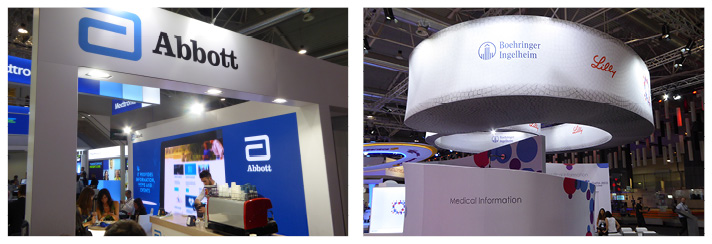
New Clinical Decision Rule Validated for Women After Venous Thromboembolism
OVER half of women who report a first, unprovoked venous thromboembolism (VTE) could be spared the burdens, costs, and risks of lifelong anticoagulant therapy using a new clinical decision rule (CDR) tested in the REVERSE II trial.
The HERDOO2 rule is now the only validated CDR to assist in deciding which patients can discontinue anticoagulants after unprovoked VTE.
The HERDOO2 rule, presented in a ESC press release dated 30th August 2016, is named according to the four risk factors that must be considered in order to determine a patient’s risk of VTE recurrence:
- Hyperpigmentation, Edema, or Redness in either leg
- D-dimer <250 μg/ml on anticoagulants
- Obesity with BMI >30 kg/m2
- Older than age 65
The study enrolled 2,779 patients, men and women, with a mean age of 54.4 years and with a first, unprovoked VTE, following completion of anticoagulant therapy for between 5 and 12 months. The results at 1-year follow-up showed low-risk women, who had stopped anticoagulant therapy (n=591), had a 3% recurrence rate of VTE, compared to an 8.1% rate in high-risk patients who also stopped (n=323).
The HERDOO2 rule was prospectively validated as being able to identify whether women were at a low risk of recurrence after an unprovoked VTE. Women who have one, or none, of the risk factors are considered low risk. Men, however, remain at high risk even if they too meet only one, or none, of these criteria.
Study investigator, Prof Marc Rodger, Chief and Chair of the Division of Hematology, Ottawa Hospital, Ottawa, Canada, reiterated the positive outcomes: “Since current consensus guidelines suggest anticoagulants should be continued indefinitely in all patients with unprovoked VTE and non-high bleeding risk, our results are potentially practice-changing.”
Future studies will seek to answer the questions of whether indefinite anticoagulation is necessary in men, high-risk women, and post-menopausal women aged ≥50.
Alternative Anticoagulant Before Cardioversion Identified in Large Trial
THE LARGEST randomised clinical trial of anticoagulation for cardioversion in patients with atrial fibrillation (AF) has shown edoxaban to be a relatively safe alternative to conventional therapy for patients prior to electrical correction of their abnormal heartbeat.
The results of the ENSURE-AF trial indicate that edoxaban, a non-vitamin K antagonist (VKA) oral anticoagulant, has shown it is “an effective and safe alternative” to standard VKA therapy, according to a ESC press release dated 30th August 2016.
In the Phase IIIb study, 2,199 patients with non-valvular AF scheduled for electrical cardioversion after anticoagulation therapy were included from 239 different study sites across Europe and the USA. Edoxaban was administered once daily to 1,095 patients and the remaining 1,104 patients received the best conventional therapy (enoxaparin/warfarin) with dosage depending on patient characteristics. Cardioversion was performed on 988 (90.2%) of the patients receiving edoxaban and 966 (87.5%) of those receiving enoxaparin/warfarin.
The results showed a comparable rate of endpoint occurrence in both groups. The primary purpose of the study was to compare the incidences of the composite endpoint of stroke, systemic embolic event, myocardial infarction, and cardiovascular death at Day 28. The rate was measured at 0.5% among patients receiving edoxaban versus a rate of 1.0% among patients receiving enoxaparin/warfarin (odds ratio [OR]: 0.46; 95% confidence interval [CI]: 0.12–1.43).
The study also found a comparable rate in the primary safety endpoint of major and clinically relevant non-major bleeding events at Day 30, with a 1.5% rate in the edoxaban group and 1.0% in the standard therapy group (OR: 1.48; 95% CI: 0.64–3.55). Study investigator Prof Andreas Goette, Specialist in Internal Medicine and Cardiology, St. Vincenz-Krankenhaus hospital, Paderborn, Germany, explained that: “Edoxaban had similar rates of major bleeding and thromboembolism compared to well-managed, optimised enoxaparin/warfarin therapy. The results were similar whether transoesophageal echocardiography guidance was used or not, whether patients had received prior anticoagulation or not, and in patients with a broad range of associated comorbidities.”

No Benefit in Intensive Medical Therapy for Heart Disease Patients
A PROACTIVE strategy in treating high-risk coronary artery disease (CAD) has been described as having no clinical benefit over conventional management by investigators from the ACTION study group according to a ESC press release dated 29th August 2016.
In high-risk CAD patients, an active strategy of detecting and treating asymptomatic multisite artery disease (MSAD) alongside a programme of intensive medical therapy had no significant differences in outcomes at 2-year follow-up compared to the approach of managing only symptomatic coronary and extra-coronary lesions.
No significant difference was found in the rates of all-cause mortality, rehospitalisation for an ischaemic event, or organ failure at 2-year follow-up by the AMERICA study.
The 521 CAD patients enrolled on the study were considered high-risk based on a diagnosed three-vessel disease within the past 6 months, or acute coronary syndrome in the past month (in patients ≥75 years old).
These patients were then randomised into groups: i) proactive prevention group (PAG), with a programme including revascularisation of asymptomatic MSAD when deemed necessary, alterations in lifestyle, and an aggressive pharmacological approach (n=263); or ii) a group receiving a conventional strategy (CSG) based on treatment of CAD and only symptomatic extra-coronary lesions (n=258).
Rates of the primary endpoint were not significantly different, with 44.9% in the PAG compared to 43.0% in the CSG. The outcome of the secondary endpoint, a composite of all-cause death, myocardial infarction, stroke, and any revascularisation, had similarly non-significant rates of 12.9% in the PAG and 13.6% in the CSG, while major bleeding events occurred at rates of 4.6% and 5.0% in the PAG and CSG, respectively.
“Possible explanations for the failure of the proactive strategy were that revascularisation of MSAD lesions was rare and that pharmacological treatment was close to optimal in both groups,” explained lead investigator Prof Jean-Philippe Collet, Institut de Cardiologie, Hôpital de la Pitié Salpêtrière, Paris, France.
Stenting Deemed Unnecessary for One-Quarter of Myocardial Infarction Patients
AN ALTERNATIVE treatment process for heart attack patients has been identified, rendering the need for stenting to re-open patients’ blocked arteries unnecessary in over one-quarter of patients. Instead, these patients can receive only antithrombotic medications, according to a ESC press release dated 30th August 2016.
Lead investigator Dr Ik-Kyung Jang, Harvard Medical School, Massachusetts General Hospital, Boston, Massachusetts, USA, commented: “If we can identify ACS patients with erosion without an invasive procedure, those patients may be triaged to a conservative therapy pathway instead of invasive catheterisation and stent implantation,” following results from the EROSION study.
For 60% of patients, ACS is caused by plaque rupture, whilst for 25–44% of patients it is caused by plaque erosion, according to Dr Jang. The study used optical coherence tomography to identify plaque erosion and plaque rupture in 405 patients during coronary angiography. In 103 (25.4%) of the patients, plaque erosion was found to be the cause of ACS; 60 of these patients had a residual diameter stenosis of <70% on angiogram, thrombolysis in myocardial infarction (TIMI) flow grade of 3, and were stable, showing no symptoms.
These patients were given only antithrombotic medications, and stenting was considered unnecessary. They were treated with dual antiplatelet therapy, receiving aspirin and ticagrelor, as well as glycoprotein IIb/IIIa in 63.6% of patients.
The primary endpoint of the study was defined as a >50% reduction in the size of the clot. According to Dr Jang, the patients had a follow-up at 1 month, at which 47 of the 60 patients had met the primary endpoint and 22 of the patients had no clot at all. One patient died of gastrointestinal bleeding, and another showed no improvement in the stenotic artery at the 1-month follow-up. Generally however, clot volume decreased from 3.7 to 0.2 mm3 and minimal flow area increased from 1.7 to 2.1 mm2. Randomised controlled trials will be required to assess the long-term outcomes in these patients.

